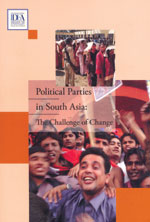 Political Parties in South Asia: The Challenge of Change, KC Suri et al, International IDEA, 2007, Stockholm, 144pp, price not mentioned |
The worst victims of every experiment in controlled democracy have been political parties. They have failed to emerge as principal actors of political process.
With the exception of India, which was closer to the Soviet Union than to the USA, malfunctioning parties are common features of most countries going through the democratisation process.
Some of the clearest illustrations of this come from the experiments in limited democracy carried out during the Cold War and the 1960s in particular. In Indonesia, this hybrid regime was herded by a military strongman-turned-civilian ruler and called "guided democracy". In Pakistan, General Ayub Khan called his dictatorship "basic democracy" and parties are today little more than platforms for ambitious individuals. In Bangladesh, political enterprises are inherited like family firms. Political parties in Nepal, where King Mahendra spoke of "indigenous democracy" suited to the "air, water, and soil" of Nepal, can be seen as a microcosm of the South Asian scene.
International IDEA's new publication, Political Parties in South Asia: The Challenge of Change is a study report of political parties of Bangladesh, India, Nepal, Pakistan, and Sri Lanka. Its seven chapters discuss the context, content, circumstances, conditions, and course of the region's major political parties.
Although most donors realise by now that poverty alleviation requires democratic governance-which in turn cannot occur without vibrant, dynamic political parties-party building continues to be uncharted territory. There is no formula, no replicable method for creating effective political platforms.
The problems with South Asia's parties are legion-those with hoary pasts (like the Nepali Congress) are decadent. Those with ideological insecurities, such as the UML, turn to populist demagoguery. Extremist forces like the Maoists are marked by desperation. And in most parties of significance, dynastic succession and despotic tendencies are the norm rather than exception in their internal functioning.
This is where comparative study becomes of paramount importance, especially to see and build upon the commonalities of experience. In doing this, Political Parties in South Asia comes to a striking conclusion-all of us in South Asia are more or less same-same, like that only. Benazir Bhutto in Pakistan can learn the importance of talking to sworn enemies for the sake of democracy from Nepal's octogenarian Girija Prasad Koirala. Pushpa Kamal Dahal can offer lessons in pragmatism to Prabhakaran. Madhab Nepal can benefit from the experience of Jyoti Basu. Khaleda Zia and Sheikh Hasina should meet Jayalalitha, the superstar of political comebacks.
Like most donor-funded studies, this work is data-heavy, figure-dominant, fact-deficient, and truth-starved. It has many tables and no pictures, lots of history but no memories. There is long analyses and little synthesis, a lot of explanation but less insight.
Now lack of subjectivity may have been the very purpose of the book, to present the study in a scientific format so it gains the respectability of an academic work. This publication is highly recommended to those who want to be considered serious students of South Asian politics.
CK Lal


